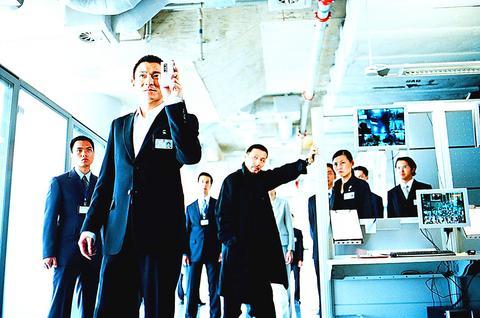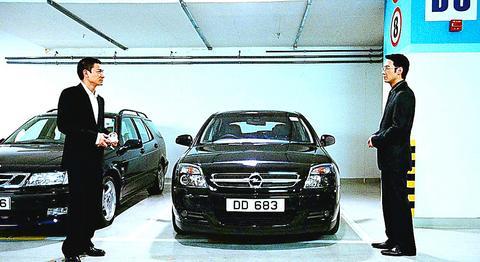A word of warning: If you haven't seen the first Infernal Affairs, the highly anticipated sequel Infernal Affairs III, opening today, will be especially confusing. If you have seen the original and the prequel Infernal Affairs II, it will still be confusing, but worth trying to make sense of.
The contemporary police/gangster film Infernal Affairs centers around two duplicitous characters. Andy Lau (劉德華) plays Ming, a triad mole sent to infiltrate the Hong Kong police force; Tony Leung (粱朝偉) plays Yan, a cop deep undercover in the triad underworld. Infernal Affairs II, released just last month, depicts the recruitment of these two as young men while revealing the equally duplicitous nature of their respective elders: Superintendent Wong, played by Anthony Wong (黃秋生), and the triad boss Sam, played by Eric Tsang (曾志偉).

PHOTO COURTESY OF GROUP POWER
This third and final installment of Hong Kong's most ambitious blockbuster franchise takes place a year after the period of this first film with equal time given to flashbacks taking place a few years prior. The abundant flashbacks allow filmmakers Andrew Lau (

PHOTO COURTESY OF GROUP POWER
One of the major reasons for the first film's success was its surplus of big-name stars. Numerous explicit references to The Godfather Trilogy, Part II introduced the epic aspirations of Infernal Affairs, bringing in more stars for more major characters. Part III ups the ante even further, and accommodating the demands of these new characters is primarily what makes the third installment difficult to follow.
Aside from a bigger role for rising star Chapman To (
Lai plays Yeung, the cold-hearted and apprehensive police executive. Chen -- the best actior in Zhang Yimou's (
In the first film, Ming was promoted to the Internal Affairs division to find the triad mole (actually himself) and Part III begins with a committee exonerating him for the bloodshed that left Yan, Superintendent Wong, and another triad mole dead. His next assignment is to continue searching for a triad mole, who has been covering his tracks by systematically executing other moles on the force. Yeung, who holds
clandestine meetings with both Shen and Sam, becomes the target of the IA investigation, with, of course, a strong possibility remaining that the guilty party is Ming himself, even though he longs to become a "good guy."
But the daily suppression of his corrupt past finally proves too much for Ming, and a dominant narrative strand in Part III is his gradual psychological breakdown. We were offered a glimpse into his pathology in the prequel, when the young Ming covets his surrogate mother (Carina Lau,
The psychological drama dovetails with more details of Yan's story, revisiting his therapy sessions with Dr. Lee, played by pop star Kelly Chen (
The film returns to the sleek visual style of the first movie, accentuating a sense of post-industrial Hong Kong in the decor of the police headquarters. But with the introduction of a few Mandarin speaking Chinese characters, as well as references to Taiwanese repatriates and arms dealers, this epic also suggests the growth of a greater China.
A huge window in Yeung's executive office looks out on Victoria Harbor, its view limited to ships and cranes without showing Hong Kong's recognizable skyline.
And so when a Chinese freighter slowly creeps by in the background, coincidently at a crucial climactic moment, we might think we are in Shanghai's Pudong district or the Pearl River Delta. Gone are those good old days from Part II of a freewheeling, colorful Hong Kong.
After all, as Shen tells a
recession-weary Sam flirting with the Chinese market, a Hong Kong gangster will never outlive a Chinese businessman.

June 9 to June 15 A photo of two men riding trendy high-wheel Penny-Farthing bicycles past a Qing Dynasty gate aptly captures the essence of Taipei in 1897 — a newly colonized city on the cusp of great change. The Japanese began making significant modifications to the cityscape in 1899, tearing down Qing-era structures, widening boulevards and installing Western-style infrastructure and buildings. The photographer, Minosuke Imamura, only spent a year in Taiwan as a cartographer for the governor-general’s office, but he left behind a treasure trove of 130 images showing life at the onset of Japanese rule, spanning July 1897 to

One of the most important gripes that Taiwanese have about the Democratic Progressive Party (DPP) is that it has failed to deliver concretely on higher wages, housing prices and other bread-and-butter issues. The parallel complaint is that the DPP cares only about glamor issues, such as removing markers of Chinese Nationalist Party (KMT) colonialism by renaming them, or what the KMT codes as “de-Sinification.” Once again, as a critical election looms, the DPP is presenting evidence for that charge. The KMT was quick to jump on the recent proposal of the Ministry of the Interior (MOI) to rename roads that symbolize

On the evening of June 1, Control Yuan Secretary-General Lee Chun-yi (李俊俋) apologized and resigned in disgrace. His crime was instructing his driver to use a Control Yuan vehicle to transport his dog to a pet grooming salon. The Control Yuan is the government branch that investigates, audits and impeaches government officials for, among other things, misuse of government funds, so his misuse of a government vehicle was highly inappropriate. If this story were told to anyone living in the golden era of swaggering gangsters, flashy nouveau riche businessmen, and corrupt “black gold” politics of the 1980s and 1990s, they would have laughed.

In an interview posted online by United Daily News (UDN) on May 26, current Chinese Nationalist Party (KMT) Chairman Eric Chu (朱立倫) was asked about Taichung Mayor Lu Shiow-yen (盧秀燕) replacing him as party chair. Though not yet officially running, by the customs of Taiwan politics, Lu has been signalling she is both running for party chair and to be the party’s 2028 presidential candidate. She told an international media outlet that she was considering a run. She also gave a speech in Keelung on national priorities and foreign affairs. For details, see the May 23 edition of this column,